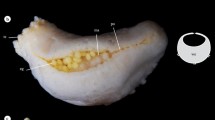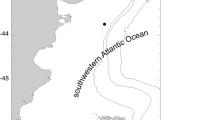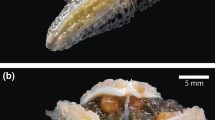Abstract
Marine invertebrates can display several reproductive strategies, from external reproduction to parental care. Internal brooding is particularly relevant in harsh conditions, like Antarctic/sub-Antarctic waters and deep-sea, since it maximizes the survival of the young. Actinostola crassicornis is an abundant and widely distributed sea anemone from the southwestern Atlantic Ocean. It can be found all along the Argentinean sea down to 1200 m depth, usually in large numbers. It is a unique species in the area, since it is a large white brooding sea anemone. We studied 75 specimens collected by the O/V Walther Herwig and the O/V Puerto Deseado all along its distribution, from about 60 m to 800 m depth, in different seasons of the year. All the specimens were sexed, and the presence of free oocytes and juveniles inside the coelenteron were assessed. Large oocytes (over 500 μm) and juveniles were found in samples from most of the sampled months. We found a larger number of female specimens, and most of the brooding specimens were female. No early developmental stages were found smaller than a sea anemone with about 12 tentacles. We conclude that A. crassicornis reproduces continuously throughout the year and that although most of the juveniles were found in females, male specimens can breed. Brooding has great benefits in terms of protecting the offspring, since predation upon the juveniles is prevented, but dispersal of the offspring is low, shown by the aggregated distribution of the species.




Similar content being viewed by others
Data availability
The datasets used during the current study are available from the corresponding author on reasonable request.
References
Averbuj A, Penchaszadeh P, Pastorino G (2018) Egg masses and development of Falsilunatia eltanini (Mollusca: Gastropoda): A deep-sea naticid from southwestern Atlantic Canyon. Mar Biol. https://doi.org/10.1007/s00227-018-3337-8
Berecoechea JJ, Brogger M, Penchaszadeh P (2017) New evidence of brooding in the deep-sea brittle star Astrotoma agassizii Lyman, 1876 from a South Western Atlantic Canyon. Deep Sea Res Part I 127:105–110
Bocharova ES (2015) Reproductive biology and genetic diversity of the sea anemone Aulactinia stella (Verrill, 1864). Hydrobiologia 759:27–38
Bocharova ES, Mugue NS (2012) Sea anemones Aulactinia stella (Verrill, 1864) (Hexacorallia, Actiniidae) can brood offspring from other individual of the same species. Dokl Biol Sci 444:173–175
Brökeland W, George K (2009) Deep-sea taxonomy—a contribution to our knowledge of biodiversity. Zootaxa 2096:6–8
Chia F (1976) Sea anemone reproduction: patterns and adaptive radiations. In: Mackie GO (ed) Coelenterate ecology and behavior. Plenum Press, New York, pp 261–270
Chia F, Rostron M (1970) Some Aspect of the reproductive biology of Actinia equina (Cnidaria: Anthozoa). J Mar Biol Assoc U K 50:253–264
Dunn D (1975a) Gynodioecy in an animal. Nature 253:528–529
Dunn D (1975b) Reproduction of the externally brooding sea anemone Epiactis prolifera Verrill, 1869. Biol Bull 148:199–218
Dunn D (1983) Sexual reproduction of two intertidal sea anemones (Coelenterata: Actiniaria) in Malaysia. Biotrópico 14:262–271
Fautin D (1984) More Antarctic and Subantarctic sea anemones (Coelenterata: Corallimorpharia and Actiniaria). Antarct Res Ser 41:1–42
Fautin D (2013) Hexacorallians of the World. https://geoportal.kgs.ku.edu/hexacoral/anemone2/index.cfm. Accessed October 2018
Flores J, Brogger M, Penchaszadeh PE (2019) Reproduction and development of the brooding sea urchin Austrocidaris canaliculata from deep-sea off Argentina. Deep Sea Res Part I 143:35–42
Häussermann V (2004a) Identification and taxonomy of soft-bodied hexacorals exemplified by Chilean sea anemones; including guidelines for sampling, preservation and examination. J Mar Biol Assoc U K 84:931–936
Häussermann V (2004b) The sea anemone genus Actinostola (Verrill 1883): variability and utility of traditional taxonomic features, and a re-description of Actinostola chilensis (McMurrich 1904). Polar Biol 28:26–38
Hertwig R (1882) Die Actinien der Challenger Expedition. Gustav Fischer, Jena
Humason G (1967) Animal tissue techniques. Freeman and Company, San Francisco
Jennison B (1981) Reproduction in three species of sea anemones from Key West, Florida. Can J Zool 59:1708–1719
Larson P (2017) Brooding sea anemones (Cnidaria: Anthozoa: Actiniaria): paragons of diversity in mode, morphology, and maternity. Invertebr Biol 136(1):92–112
Larson PG, Daly M (2016) Phylogenetic analysis reveals an evolutionary transition from internal to external brooding in Epiactis Verrill (Cnidaria: Anthozoa: Actiniaria) and rejects the validity of the genus Cnidopus Carlgren. Mol Phylo Evol 94:548–558
Larson PG, Hamel J-F, Mercier A (2012) Redescription and notes on the reproductive biology of the sea anemone Urticina fecunda (Verrill, 1899), comb. nov. (Cnidaria: Actiniaria: Actiniidae). Zootaxa 3523(1):69–79
Lauretta D, Penchaszadeh PE (2017) Gigantic oocytes in the deep sea black coral Dendrobathypathes grandis (Antipatharia) from the Mar del Plata submarine canyon area (southwestern Atlantic). Deep Sea Res Part I 128:109–114
Martinez M, Penchaszadeh PE (2017) A new species of brooding Psolidae (Echinodermata: Holothuroidea) from deep-sea off Argentina, Southwestern Atlantic Ocean. Deep Sea Res Part II 146:13–17
Martinez M, Alba-Posse E, Lauretta D, Penchaszadeh PE (2018) Developmental stages in the brooding sea cucumber Cladodactyla crocea (Lesson, 1830) in the Southwestern Atlantic Ocean. Polar Biol 41:1237–1244. https://doi.org/10.1007/s00300-018-2280-y
Orr J, Thorpe JP, Carter MA (1982) Biochemical genetic confirmation of the asexual reproduction of brooded offspring in the sea anemone Actinia equine. Mar Ecol Prog Ser 7:227–229
Ottaway J (1979) Population ecology of the intertidal anemone Actinia tenebrosa II. Geographical distribution, synonymy, reproductive cycle and fecundity. Aust J Zool 27:273–290
Pearse J, Mooi R, Lockhart S, Brandt A (2009) Brooding and species diversity in the Southern Ocean: selection for brooders or speciation within brooding clades? In: Krupnik I, Lang M, Miller S (eds) Smithsonian at the poles: contributions to international polar year science. Smithsonian Institution Scholarly Press, Washington, pp 181–196
Penchaszadeh PE, Teso V, Pastorino G (2017) Spawn in two deep-sea volute gastropods (Neogastropoda: Volutidae) from southwestern Atlantic waters. Deep Sea Res Part I 130:55–62
Penchaszadeh PE, Pastorino G, Martinez M, Miloslavich P (2019) Spawn and development of the gastropod Americominella longisetosa (Castellanos and Fernández, 1972) (Mollusca: Buccinidae) from the Southwestern Atlantic deep sea. Deep Sea Res Part I 143:43–49
Pertossi R, Brogger M, Penchaszadeh PE, Martinez M (2019) Reproduction and developmental stages in the crinoid Isometra vivipara Mortensen, 1917 from the southwestern Atlantic. Polar Biol 42:807–816
Riemann-Zürneck K (1978) Actiniaria des Südwestatlantik IV. Actinostola crassicornis (Hertwig, 1882) mit einer Diskussion verwandter Arten. Veröff Inst Meeresforsch Bremer 17:65–85
Riemann-Zürneck K (1986) Zur Biogeographie des Südwestatlantik mit besonderer Berücksichtigung dera Seeanemonen (Coelenterata: Actiniaria). Helgol Meeresunter 40:91–149
Rivadeneira P, Brogger M, Penchaszadeh PE (2017) Aboral brooding in the deep water sea star Ctenodiscus australis Lütken, 1871 (Asteroidea) from the Southwestern Atlantic. Deep Sea Res Part I 123:105–109
Rodríguez E, Orejas C, López-González PJ, Gili JM (2012) Reproduction in the externally brooding sea anemone Epiactis georgiana in the Antarctic Peninsula and the Weddell Sea. Mar Biol 160:1–14
Rodríguez E, López-González P (2013) New records of Antarctic and Sub-Antarctic sea anemones (Cnidaria, Anthozoa, Actiniaria and Corallimorpharia) from the Weddell Sea, Antarctic Peninsula, and Scotia Arc. Zootaxa 3624:1–100
Rostron MA, Rostron J (1978) Fecundity and reproductive ecology of a natural population of Actinia equina (Cnidaria: Anthozoa). J Exp Mar Biol Ecol 33:251–259
Sánchez N, Pastorino G, Penchaszadeh PE (2018) Giant eggs in the gastropod Aforia obesa (Conoidea: Cochlespiridae) in Southwestern Atlantic deep-waters. Zool Anz 276:94–99
Suvarna SK, Layton C, Bancroft JD (2013) Bancroft's theory and practice of histological techniques. Elsevier, Churchill Livingstore
Teso V, Penchaszadeh PE (2019) Development of the gastropod Trochita pileus (Calyptraeidae) in the sub-Antarctic Southwestern Atlantic. Polar Biol 42:171–178
Zar J (2010) Biostatistical analysis, 5th edn. Pearson Prentice Hall, New Jersey
Zamponi M (1984) Los primeros estadios del desarrollo en Actinostola crassicornis (Hertwig, 1882) (Actiniaria: Actinostolidae). Neotrópica 30:111–120
Acknowledgements
Many thanks to the crew of the O/V Puerto Deseado for their assistance during the expeditions and to the curator of the ZMH (Andreas Schmidt-Rhaesa) for the access to the collection and specimens. Thanks to Alejandra Lauretta for improving the English of the manuscript. This manuscript was greatly improved by the comments and suggestion of Ekaterina Bocharova, Vreni Häussermann and a third anonymous review.
Funding
This work was partially founded by PICT 2013-2504 from the Agencia Nacional de Promoción Científica y Tecnológica to Pablo Penchaszadeh, a PIP 2017-0643 from the National Scientific and Technical Research Council to DL and MM, a DAAD (German Academic Exchange Service) to DL and a PADI foundation grant to DL.
Author information
Authors and Affiliations
Corresponding author
Ethics declarations
Conflict of interest
The authors declare that they have no conflict of interest.
Ethical approval
All applicable international, national, and/or institutional guidelines for the care and use of animals were followed.
Research involving human and animal rights
All the specimens of Actinostola crassicornis used in this study were approved by the corresponding authorities both in the Museo Argentino de Ciencias Naturales “Bernardino Rivadavia” and in the Zoological Museum of Hamburg.
Additional information
Publisher's Note
Springer Nature remains neutral with regard to jurisdictional claims in published maps and institutional affiliations.
Rights and permissions
About this article
Cite this article
Lauretta, D., Vidos, C., Martinez, M.I. et al. Brooding in the deep-sea sea anemone Actinostola crassicornis (Hertwig, 1882) (Cnidaria: Anthozoa: Actiniaria) from the southwestern Atlantic Ocean. Polar Biol 43, 1353–1361 (2020). https://doi.org/10.1007/s00300-020-02713-3
Received:
Revised:
Accepted:
Published:
Issue Date:
DOI: https://doi.org/10.1007/s00300-020-02713-3




